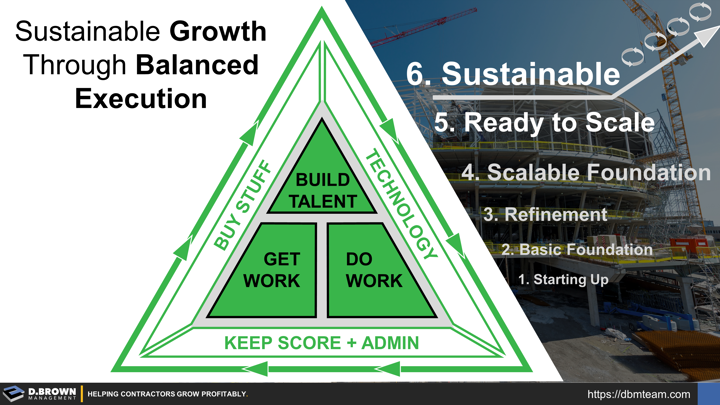If you take the approach of trying to identify everything about the business that is "wrong" or could be improved, then putting that on a task list and managing it like a project, it will often over-stress yourself and your team without translating into sustainable growth.
We define sustainable growth as a contractor being able to consistently achieve business outcomes that are 2-3X industry benchmarks including safety, while growing, and having succession readiness at all levels.
Sustainable growth requires a balanced approach.
- Operating consistently to address the daily business challenges of getting work and doing the work.
- Continuously improving a little with each new project.
- Leading the bigger changes required at each stage of growth including strategy, systems, structure, and leadership focus.
This simple diagram is a reminder of that balanced approach.
- Get Work: Right alignment with strategic market choices, aligned with operational capabilities, at the right price, and with the right terms. Done right, business development is as manageable a process as project delivery. Opportunity evaluation and the decision to pursue must be as disciplined as the plan for a crane lift.
- Do Work: Contractors exist to build projects. Sustainably growing contractors build progressively more, larger, and complex projects each year. Project teams consistently improve on their seven basic objectives.
- Build Talent: Nothing happens without the people. The ability to recruit, develop, and retain the right talent is the biggest differentiator between contractors. Part of doing this is having a steady flow of the right work (projects) in front of them. This is your Talent Value Stream (TVS).
- Keeping Score & Admin: This forms a foundation - knowing the score at all levels is required for good decision making. The administration side including management systems and structure are what enable growth that is profitable and sustainable. Note that scorekeeping alone rarely leads to sustainable growth - 16 Reasons for Scorekeeping Failure.
- Buy Stuff: From project materials to subcontractors to equipment to buildings, the majority of a contractor's costs are typically things they buy. Effective purchasing from the initial quotes that estimates are based through to the logistics up to the moment of installation are critical for sustainable growth.
- Technology: Technology touches nearly every aspect of the construction process yet is still poorly leveraged by most - from the individual level through to the company level. Just buying technology alone won't change outcomes without deep understanding of the different layers of technology and the discipline to fully integrate then manage.
This model is not meant to describe the whole of a construction business. Just a simple reminder of the basics. This gets unpacked to the next level of detail with the Contractor Business Model.

